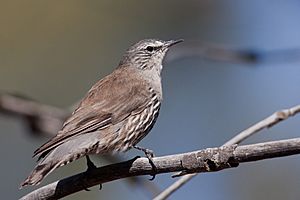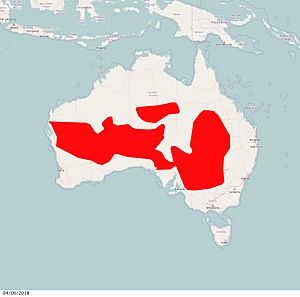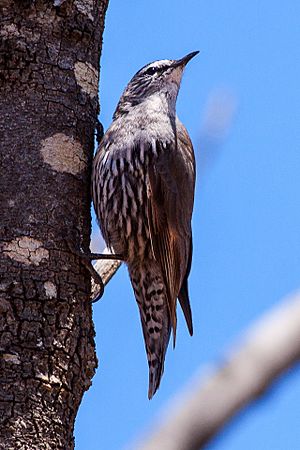White-browed treecreeper facts for kids
Quick facts for kids White-browed treecreeper |
|
|---|---|
 |
|
| Conservation status | |
| Scientific classification | |
| Genus: |
Climacteris
|
| Species: |
affinis
|
 |
|
| Distribution of Climacteris affinis in red | |
The White-browed Treecreeper (Climacteris affinis) is a small bird found in Australia. It's the only treecreeper in its family that lives in dry, desert-like areas. These birds are known for climbing tree trunks to find insects and other small creatures hiding under the bark. Even though some groups of these birds have become smaller, the White-browed Treecreeper is currently listed as a species of Least Concern by the IUCN. This means it's not in immediate danger of disappearing.
Contents
Discovering the White-browed Treecreeper's Family
The White-browed Treecreeper (Climacteris affinis) is one of seven types of treecreepers found only in Australia and Papua New Guinea. For a long time, scientists weren't sure how these birds were related to other bird families.
Bird Family Tree: A Closer Look
Thanks to new ways of studying DNA, we now know that treecreepers are most closely related to bowerbirds and catbirds. These three bird families are thought to be some of the oldest groups of 'songbirds'. Songbirds are a large group of birds known for their complex songs. They started to develop and spread out in Australia a very long time ago.
Scientists believe that treecreepers and bowerbirds/catbirds split into separate families between 58.7 and 35.2 million years ago.
Ancient Treecreeper Fossils
Within the treecreeper family, there are two main groups: Climacteris and Cormobates. Scientists estimate these two groups separated during the Eocene and early-Miocene periods. This is supported by old fossils found in Queensland, Australia. These fossils show that even ancient treecreepers climbed tree trunks to find food. This suggests that their special climbing style developed very early in their history.
The name Climacteris comes from a Greek word meaning 'the rung of a ladder'. This refers to how these birds climb trees. The species name affinis is Latin for 'allied'. It means this bird looks similar to the Red-browed treecreeper (Climacteris erythrops).
White-browed Treecreeper Subspecies
There are two recognized types, or subspecies, of the White-browed Treecreeper:
- C. a. affinis Blyth, 1863 – Found in Australia, east of Spencer Gulf. This type has a grey rump, uppertail coverts, and tail.
- C. a. superciliosus North, 1895 – Found in Australia, west of Spencer Gulf. This type has a brown rump, uppertail coverts, and tail.
How to Spot a White-browed Treecreeper
The White-browed Treecreeper is about 14–16 cm long. Its wingspan is around 22 cm, and it weighs about 21 grams.
What They Look Like
Adult males are mostly dark grey on top, including their head, neck, and rump. Their back and shoulder feathers are brown. They have a black band near the end of their tail. Their face has black areas near the eyes, a white eyebrow, and black and white stripes on their ear feathers. Their chin is white, and their throat is brownish-grey. The upper chest is grey, while the lower chest, belly, and sides have black and white stripes. The feathers under their tail are also barred black and white.
Females look similar to males. However, they have a reddish stripe above their eyebrow. They also have dull white streaks, sometimes with a reddish tint, on the center of their upper chest. Both males and females have a black, slender bill about 1.5–2 cm long. Their eyes are dark brown, and their legs and feet are black. Young birds have a pale grey bill and less clear face patterns.
How They Fly
White-browed Treecreepers have medium-long, wedge-shaped wings and a square tail. When they fly long distances, their flight is wavy. They flap their wings briefly, then glide for a long time. During these glides, you can see a buff-colored bar on their wings.
Similar Birds
The Brown treecreeper (Climacteris picumnus) looks a bit like the White-browed Treecreeper. However, the Brown Treecreeper has duller chest stripes. Its ear feather stripes are only on the back part of its ears. Also, the Brown Treecreeper makes short, sharp 'peep' calls. This is very different from the White-browed Treecreeper's long, insect-like 'prrrpt' calls.
Where White-browed Treecreepers Live
White-browed Treecreepers live in dry and semi-dry areas across southern Australia. You won't find them in Tasmania. The two subspecies live in different areas. C. a. affinis is found east of the Spencer Gulf, and C. a. superciliosus is found to the west.
These birds live in different types of woodlands and shrublands. These areas are often filled with Acacia, Casuarina, or Callitris trees. They can live in places with thick or open undergrowth.
White-browed Treecreepers are sedentary, meaning they don't move around much. Pairs or small groups actively protect their territory all year long. These territories can be quite large, averaging about 8.4 hectares in some places.
How White-browed Treecreepers Live
What They Eat and How They Forage
The White-browed Treecreeper is a specialist at finding food on tree bark. It mostly eats insects, especially ants. It finds them on and under the bark of tree trunks and branches. These birds climb trees by 'inching' their way up. They lift their lower foot to the same level as their upper foot, then move the upper foot higher. This is different from some other climbing birds that hop or hitch up trees.
Once a White-browed Treecreeper reaches the top of a tree, it glides down to a lower spot on a nearby tree. Then it starts climbing again. These birds also often look for food on the ground among logs and fallen leaves.
White-browed Treecreepers can forage alone or in small family groups. In winter, they might join groups with other insect-eating birds.
Special Adaptations for Climbing
White-browed Treecreepers have several special body features that help them climb trees and find food. These features are mostly in their legs, feet, and toes. Their toes are longer, which helps them grip the tree better. Their claws are long and strongly curved, also helping them hold on. They also have special toes that are partly joined together and smaller pads on the bottom of their feet.
Additionally, Climacteris species can move their back toe separately from their front toes. This allows them to make very small adjustments to their grip on the tree.
Reproduction and Life Cycle
The White-browed Treecreeper's breeding season changes depending on where they live. It can start as early as July in the west or August in the east, and continues until November.
How They Raise Their Young
White-browed Treecreepers can breed as a pair, or they can have 'helpers'. These helpers are usually male offspring from previous years, and there can be 1 to 3 of them. The helpers assist with almost all nesting activities, except for incubating the eggs and brooding the chicks. Only the female does those jobs.
These birds build shallow, saucer-shaped nests inside tree hollows. They make their nests from bark fibers, grass, twigs, and small branches. They line the nest with feathers, fur, plant fluff, and wool. The female lays 1 to 3 pinkish-white eggs. These eggs have reddish and purplish-brown speckles. She incubates them for 17–18 days.
The young birds stay in the nest for about 25–26 days. After they leave the nest, they still rely on their parents and helpers for food for up to 37 days. Even though they might raise up to two groups of chicks per season, White-browed Treecreepers don't have many young birds survive. On average, only about 1.58 young birds fledge (leave the nest) per breeding group each year.
Dangers to White-browed Treecreepers
The White-browed Treecreeper faces dangers like habitat loss. This happens when land is cleared for other uses, breaking up their living areas. These threats have caused the number of these birds to go down in some places. For example, in Victoria, Australia, the species is now listed as Threatened under state laws. The White-browed Treecreeper is also considered a species that could be greatly affected by climate change.
Conservation Status
The White-browed Treecreeper is not listed as threatened under Australia's national Environment Protection and Biodiversity Conservation Act 1999. However, its conservation status can be different in various Australian states. For example:
- In Victoria, the White-browed Treecreeper is listed as threatened under the Flora and Fauna Guarantee Act (1988). This law has led to a plan to help the species recover and manage its future.
- On the 2007 list of threatened animals in Victoria, the White-browed Treecreeper is listed as vulnerable. This means it's at high risk of becoming endangered.
See also
 In Spanish: Corretroncos cejiblanco para niños
In Spanish: Corretroncos cejiblanco para niños



